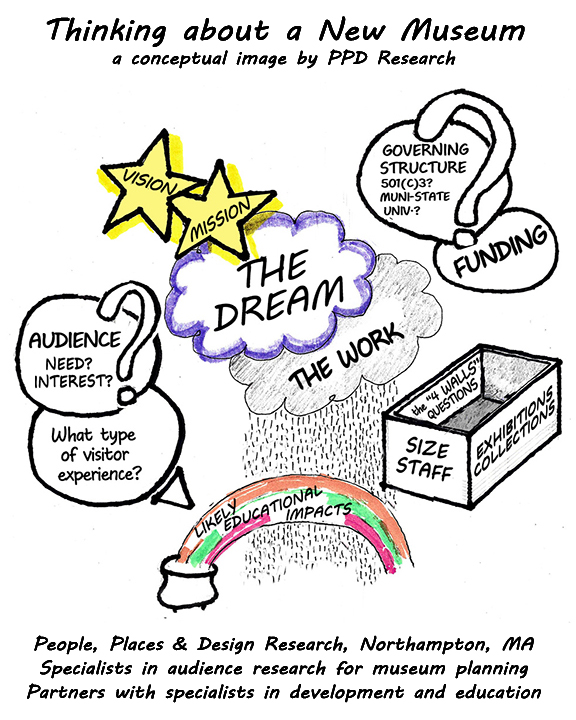We have many examples of community/metropolitan area research, undertaken to inform planning of new museums.
Museums that relocated and reinvented themselves
Exploratorium, San Francisco CA. Big issues: moving from a family-safe area (but hard to find) to a busy downtown area, concern about lapsed visitors and dependence on children as motivation for a visit, content programming choices
Museum of Natural History, University of Michigan, Ann Arbor MI. Big issues: reaching community residents despite inhibitions of access to campus, attracting students for reasons other than a class assignment, the fading appeal of ‘natural history’ vs. science
The Tech Museum, San Jose CA. Big issues: the potential techie audience in Silicon Valley, designing for families, perceptions of four major concept areas
Science Museum of Minnesota, St. Paul MN. Big issues: program planning choices about the existing four permanent galleries, seeking to unpack the image of ‘educational,’ understanding which audience types are being well-served
History Colorado, Denver CO. Big issues: lack of local attendance, lack of appeal of history to families, development of storylines that would counter those problems
Hershey Museum, Hershey PA. Big issues: a location to serve local-regional audiences when Hershey Park was filled with mostly out-of-area amusement park visitors, program choices beyond the core exhibition about Milton Hershey
Wichita Science Center, Wichita KS. Big issues: combining with the local children’s museum, seeking a greater audience, connection to downtown or not
Asian Art Museum, San Francisco CA. Big issues: moving to downtown from Golden Gate Park, understanding why people are attracted to Asian art
New Museums
MASS MoCA, North Adams MA. Big issues: a remote location, contemporary art, at the fringe of a mostly-summer vacation area, ability to attract destination visitors
National Underground Railroad Freedom Center, Cincinnati OH. Big issues: possible differential interest among white and African American residents, day trip destination?, historic location on the Ohio Riverfront, the appeal of the subject & relevance to today
Minnesota History Center, St. Paul MN. Big issues: low public interest in history museums, defining and seeking non-traditional audiences, understanding what’s meaningful about history to the range of generations
Children’s Museum of the Arts, Soho, New York NY. Big issues: other existing children’s museums in the city, the focus on arts, parents’ perception of location
When museums undertake a move, that usually prompts an array of questions and thoughtful planning issues about audience development, visitor experience planning and exhibit master planning. While considering those questions, here are three criteria for effective audience research that you might want to keep in mind:
Define a target audience that you don’t know enough about. Thinking strategically, you should be certain that you satisfy your existing ‘core audience’ – do you know enough about them? – and then you should define at least one additional target audience that you think you could attract. It would be helpful to know what proportion of your existing audience they are, and then you could use audience research to find out whether more people of that audience type are aware of you, interested, and what would prompt them to visit?
Learn something new. A big challenge in doing community research is to assess perceptions of a museum in a non-judgmental way (not: if you don’t visit this museum, you’re bad). This approach requires an order of questions and phrasing of questions that explores each individual’s existing interests, allows them to say negative, inhibiting or apathetic things about this museum if that’s the way they feel, and the nature of the questions doesn’t try to persuade them into saying they will visit in the future. Their honesty about deciding to visit museums in general, and your museum in particular, will help you make important decisions.
Search for long-term connections rather than flash-in-the-pan impressions. What could change in people’s minds that would lead to having your museum “on their list” of things they like to do? Are they aware of it now? Are people inhibited about it for some reason? What museums do they go to repeatedly, and why? Is the ‘program audience’ (which is an oversimplification, because there are probably many different audiences coming to the range of programs you offer) also a general museum/ exhibit visitor? Audience development specialists say that a “silver bullet” (e.g., a super-popular show) doesn’t necessarily lead to a long-term relationship with audiences (and sometimes raises expectations that can’t be fulfilled later).

